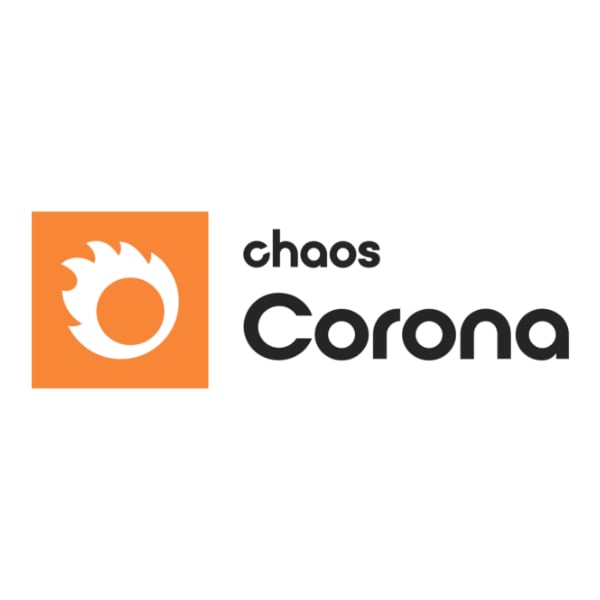Chaos Corona Premium (Annual)
Chaos Corona Premium (previously known as Corona Renderer) is a CPU-based renderer for Autodesk 3ds Max and Maxon Cinema 4D.
Chaos Corona Premium is also available monthly, and Chaos Corona Solo is a straightforward option.
Please note: Chaos Corona now works with both 3ds Max and Cinema 4D under a single licence. There is no longer an option to purchase Corona for each separate host program.
Get FREE Chaos Corona training and earn a portfolio-ready certificate from ArchAdemia! Purchase an annual Corona licence, and we will be in touch with access information.
Offer ends 08/06/2025. New Corona customers only. Limited spots available.Chaos Corona Premium (Annual Subscription) - Photorealistic architectural rendering for 3ds Max and Cinema 4D
Corona Renderer is a powerful yet easy-to use-renderer which doesn't require any special hardware to run. Corona incorporates a wide range of features that allow a high level of control and customisation while being relatively affordable within the render market.
Why Choose Chaos Corona?
Excellent Rendering Quality
- Rendering Quality- Corona Renderer offers both biased and unbiased rendering solution at the user’s discretion. In both cases it delivers predictable, reliable, and physically plausible results with no compromises in quality.
- Biased and Unbiased Rendering - Users can render in a fully unbiased mode and use advanced rendering algorithms like BDPT/VCM to get the most realistic, true-to-life results - or the defaults can be used, which is a slightly biased solution. This is very close to being unbiased, however it considerably reduces render time and increases flexibility. This is the recommended solution as it works straight out of the box with no setup whatsoever. Even in this mode, Corona will always deliver crisp, realistic results without splotches, interpolation artifacts or any other visual imperfections.
- UHD Cache - Traditionally, users had to choose to either use unbiased algorithms without any caching and wait long time for all renders, or use biased caching algorithms, and deal with splotches, missing shadows, and sensitive input parameters. Corona merges the best of both worlds. Its cached solution, called “UHD cache”, is significantly faster than plain path tracing, but does not suffer from artifacts, missing contact shadows, or complicated UI controls.
- Glass without Caustics - Caustics can be difficult to compute, especially when using path tracing. But in many cases, water or glass look plausible even without caustics, window glass panels being prime examples. Because of this, caustics have been disabled by default. This significantly reduces render times, and if caustics are needed they can easily be enabled with the “Caustics” checkbox in Corona material.
- Shadow Catcher - Corona implements its own shadow catcher (matte/shadow) solution. It is a single material with all the necessary controls in one place – there is no need to combine special materials with other special texmaps. It works especially well with the interactive rendering for rapid camera and illumination matching. Advanced features, such as light illuminators and matte bump mapping, are of course supported.
- Environment Overrides - You can use different environment maps for reflections, refractions and direct visibility from the camera. For example you can use a clear sky HDRI as a light source and a second cloudy HDRI just for reflections and refractions.
Accurate Lighting
- Lights - The whole process of creating lights is designed to give artists complete control over their scene while being fast and intuitive. There are no sampling multipliers, no differences between using light objects and materials, and no need to create artificial fill or dome lights. Users can use HDRI, IES files, Sun & Sky system, 3ds Max lights, Corona Lights, or turn any mesh object into light simply by assigning to it the Corona Light Material.
- Flexible Lights - Users can make any light source invisible to the camera as well as invisible to reflections/refractions. Shadows can be turned on/off, and specific objects can be included/excluded from receiving illumination from any Corona light. Backplates can be easily created with the invisible to GI option. 3ds Max default lights are fully supported.
- Corona Lights and Corona Light Material - There is no difference in the behavior of Corona Lights and Corona Light Material. Both of them have almost the same options and deliver the same results. So it is up to the artist to use what is more convenient.
- Lights and Rendering Speed - In Corona, there is very little penalization for using mesh lights with high polycount. They will perform as well as low-poly ones with the same shape. Additionally, version 1.0 improves the sampling of directional/IES lights. They now render almost as fast as regular diffuse lights.
- No more Dome Lights for HDRI - Users do not need to set up any dome light object for HDR image-based rendering. Just put the HDRI into a 3ds Max environment and it's done. There is also no need to put downsampled/blurred versions of the map into a GI override slot – HDRIs in Corona work always fast and without splotches, regardless of resolution or complexity.
Materials
- Rayswitcher Material - Rayswitcher material and texture allow a wide range of artistic tweaks when rendering with Corona. Use them to create materials invisible to camera or not affecting GI, to reduce or increase color bleeding, and more.
- Material Preview - Material preview uses the same rendering engine as the final frame rendering. The default 3ds Max material preview scene is replaced with a custom, more representative Corona scene, to get the real “What You See Is What You Get” material editor.
- GGX - Corona Renderer uses the GGX microfacet model to deliver realistically looking metals and other glossy materials. This model produces much more plausible results than legacy models such as Blinn, Phong, or Ward.
Excellent Interactive Capabilities
- Interactive Rendering - Corona Renderer brings you state-of-the-art, fully-featured interactive rendering.
- Interactive Capabilities - You can change materials and lights and create or adjust geometry while rendering. There is no need to manually restart or update the rendering, as it happens automatically usually within less than a second. It runs completely on the CPU, so it has no limitations and does not require any special hardware.
- Same Results as Animated Renders - Interactive rendering is an integral part of the Corona core. In fact, it shares over 99.9% of the regular renderer code. This means that all features of Corona Renderer are supported, and that the results are exactly the same as with the non-interactive version. Users can render motion blur, DOF, create proxies, scatter systems and more, all with instant feedback.
- Compatibility - Because our interactive and regular renderers are almost identical, all types of geometry and proxies are supported. The same goes for all the 3ds Max maps and third party maps. Even the advanced third party plugins such as Itoo Forest Pack work as expected.
Easy to Use and Learn
High Performance
What's New In Chaos Corona

Scene export from Corona to Vantage
Combine Corona's ease of use and unmatched photorealism with Vantage's high-end real-time ray tracing to achieve the archviz dream — fast and easy photoreal rendering. Now, effortlessly export scenes to Vantage, explore them in real-time and render images in seconds. Create short animations directly in Vantage and enjoy the lightning-fast speed of GPU rendering.
Note: With the introduction of Live Link in Corona 13, users will be able to import animations created in Corona for 3ds Max and Cinema 4D and render them in Vantage.

Curved Decals
Curved Decals allow users to perfectly bend labels to round or curved objects such as bottles, cups, etc., without any distortions and with incredible ease. Labels can be bent up to the full 360 degrees to map a pattern around an object. In addition, decals can now be bent around a second axis, allowing users to add decals to spherical objects like balls, balloons and more.

Corona Pattern improvements
Create new and incredibly realistic materials with the help of Corona Pattern. Geometric objects can now be used to define the shape of the crop box, allowing designers to employ snapping tools and more to get the perfect pattern.

Revamped Virtual Frame Buffer (VFB)
Experience a more streamlined workflow with the ability to save multiple LightMix setups within one render. Easily compare images with different resolutions and aspect ratios. Save time by loading a Corona EXR (.cxr) file and going straight to editing it. Enjoy these and more new features along with an enhanced user interface in the new version of the Corona Virtual Frame Buffer (VFB).

Improved Corona Sky
Fading in from day to night has never been better. The improved Corona Sky supports even lower sun angles below the horizon, which makes day/night animations and still images more realistic and immersive.).
Plus...
- Density parameter - Now Corona Sky also includes a Density parameter — lower it to make your clouds thin and wispy all the way down to invisible, or raise it to make them dense and thunderously heavy.
- Faster Caustics - Caustics now look around twice as good in the same rendering time. The more Caustics affect your scene, the greater the speed boost you'll notice.
- Caustics Surface Multiplier - With the new Caustics Surface Multiplier, you can easily adjust caustic intensity in the Beauty pass—no need for render elements or post-processing to achieve your desired results.
- Volumetric Caustics - Create breathtaking stills and animations with the new Caustics visible through volumetric materials. With this new feature, you can enable the visibility of reflected or refracted rays created from Caustics as they pass through water, smoke, and more.
- Automatic Exposure - Easily set up your scene with the new auto Exposure checkbox in the VFB. It works like a modern camera, and you can make additional adjustments using standard Exposure controls or by baking it into the tone mapping.
- AI Image Upscaling - Quickly render test animations and achieve more responsive results in Interactive Rendering with the new AI Image Upscaling. Powered by NVIDIA’s AI Upscaler, it can give you up to 4x faster rendering. Please note, this feature is designed for test animations only, as it lacks temporal consistency and may result in noticeable flickering.
- Cryptomatte by material - Enjoy a more streamlined workflow with the new Cryptomatte by material. The Cryptomatte render element now works correctly in Distributed Rendering (3ds Max) and Team Render (Cinema 4D), and when using Resume Render.
- Enhanced material conversions - The conversion from VRayMaterial to Corona Physical Material has been enhanced, improving imports from Chaos Cosmos. In Cinema 4D, the Scene Converter can now convert between Corona and C4D bitmaps and supports the conversion of V-Ray lights.
- Corona Materials now in Chaos Cosmos - The Corona Material library is now available also on Chaos Cosmos which can save you time switching between the two asset libraries.
| Brand | Chaos |
|---|---|
| Delivery Type | Digital Delivery By Email |
| Processing Time | 1 Working Day |
Hardware Requirements
Corona is entirely CPU-based (with optional GPU denoising which requires a compatible NVIDIA GPU), and offers both unbiased and biased rendering.
- CPU: Support for SSE 4.1
- RAM: 32GB minimum. But the more the better (64GB recommended)
- The optional GPU Desnoiser requires an NVIDIA graphics card.
To use the optional Fast Preview Denoiser (NVIDIA OptiX), you need an NVIDIA GPU with Maxwell or newer architecture and the newest GPU driver. Not all mobile GPUs are supported. This denoiser type is optional, and Corona works fine even if it's not installed (for example if you are using an AMD or integrated GPU).
Software Requirements
3ds Max
- Autodesk 3ds Max 2016 or newer.
- Microsoft Windows 10 64-bit or newer.
- Distributed rendering requires the free add-on, Autodesk Backburner.
Cinema 4D
- Maxon Cinema 4D R17 or newer.
- Microsoft Windows 10 64-bit or newer, Mac OS X 10.14 or newer.



